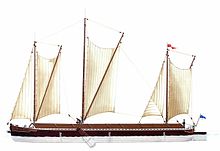Haffkahn
As Haffkahn wooden freight are barges referred to as the 19th and early 20th century in the area of Szczecin Lagoon wrong. They were mostly with a jib and three pole masts equipped, each with a large spritsail were rigged. In the 13th and 14th centuries, Oderhaff fishing boats were called hafcane , and pure cargo boats were called cane . Other names for this type of ship were pole schooner or Pommerscher Kahn .
Design
They were the largest and most seaworthy variants of the inland sailing boats. As with these, their construction developed from the wooden Kaffenkahn construction to the wooden Stevenkahn or Spitzkahn to the composite-built Mollenkahn. Around 1800 its dimensions were around 23 to 30 m in length with a board height of 2 m and in the 20th century usually corresponded to the Finow or Großfinow dimensions, in order to be able to complete the journey over the Oder and Havel to Berlin . In contrast to the Oder barges , it has not just one, but mostly three masts, each with a spriet sail. The masts could reach a length of 19 to 27 m. The distribution of the masts over the length of the ship is unusual: the main mast is about a third of the length from the front, a further third to the aft is the aft mast and the length between the bow and the main mast is halved by the so-called fore mast . The aft mast is slightly higher than the front mast. It is reported that the skippers were particularly proud of the particularly good sailing characteristics of the barges. In addition to the spriet sails, a stagsgel could be set. Only the mollusk barges had a bowsprit with a jib, a mainsail and a large staysail in front of the aft mast. The steved barges led another jib on the particularly long bowsprit. For sailing on the lagoon and the bay these barges led up to two side boards on each side.
The trade area could extend over the inland waterways to Hamburg. It could go over the Baltic Sea to Ribnitz in Mecklenburg. So it includes all Bodden waters and the areas around Rügen and Usedom.
The shipyards were located along the Szczecin Lagoon and the Peene . Haff barges were also built on Rügen . Other names for these vehicles were pole protectors, Scharendenkahn, Segelkahn or Pommern Kahn.
In the 1920s, they were also made in a few steel constructions. Representing this last variant of the Haffkähne, the EMMA can be admired as a museum ship in the German Maritime Museum in Bremerhaven.
To the wreck photo
The photo was taken in summer 1988 during surveying and documentation work in the port of Seedorf / Rügen. According to local research and information from Wolfgang Rudolph, it was the two-masted wooden Stevenkahn Elisabeth . It was built in Seedorf in 1926 and was 21.50 meters long and 4.60 meters wide. According to the remains in the wreck, it was sailed with two masts. Unfortunately, the wreck was cleared after 1990 as part of the port modernization. In front of the boat lay a wreck of a 14-meter fishing trawler made in the GDR.
literature
- Kurt Fleischfresser, Rudolf Hoffmann: Sailors from Haff and Bodden . Verlag Egon Heinemann, Norderstedt 1975, ISBN 3-87321-938-7 .
- Michael Sohn : The pole protectors from Oderhaff I. ModellWerft 11, 1994 and 12, 1994.
- Michael Sohn, Christoph Geyer: Wrecks on Rügen . In: Old Ships 2, 1991, ISSN 0938-6327 , pp. 13-18.
- Dudszus, Henriot, Krumrey: The great book of ship types . transpress VEB Verlag for Transport, Berlin 1987, ISBN 3-344-00161-2 , p. 288 .
- Wolfgang Rudolph: Rügischer Schiffbau at the shipyard in Seedorf . In: Greifswald-Stralsund yearbook. Petermänken Verlag, Schwerin 1962, pp. 257-272
- Wolfgang Rudolph: Sailing boats on the German Baltic coast . Akademie-Verlag, Berlin 1969.
- Michael Sohn: Coffee boats . A bygone form of barge. Self-published by Sohn-Art, Hennigsdorf 2013, ISBN 978-3-00-041659-0 .
- Hans Szymanski: German sailing ships. The history of the wooden cargo sailors on the German Ost- u. North Sea coast, from the end of the 18th century to the present day (publications by the Institute for Oceanography at the University of Berlin, B., Historisch-Volkswirtschaftliche Reihe, no.10). Mittler, Berlin 1934.
Individual evidence
- ↑ Dudszus, Henriot, Krumrey: The great book of ship types



